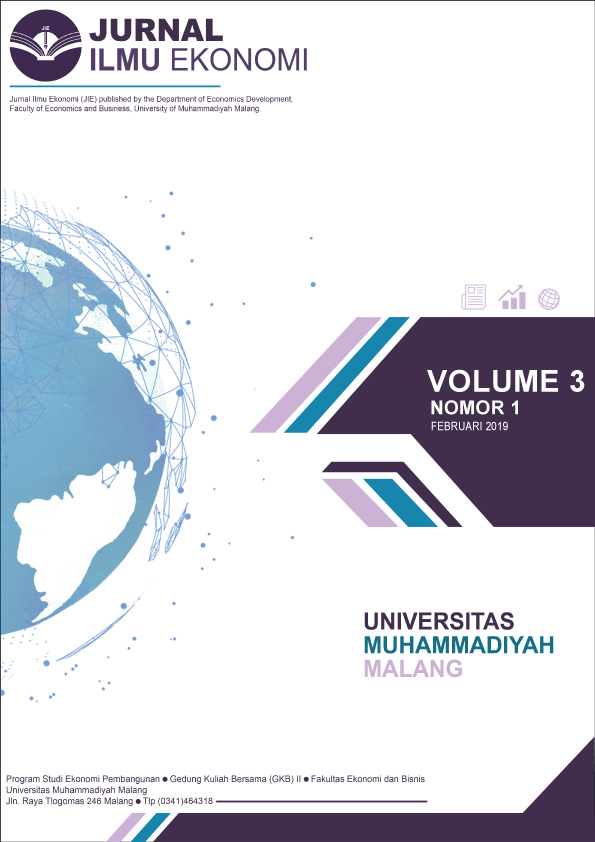ANALISIS SEKTOR EKONOMI UNGGULAN DAN PERGESERAN STRUKTUR PEREKONOMIAN KOTA BATU TAHUN 2012-2016
DOI:
https://doi.org/10.22219/jie.v3i1.8233Abstract
Economic development must include economic growth, where economic development greatly encourages economic growth and economic growth facilitates the process of economic development. With this to know the leading economic sectors in the economy in Batu City in 2012-2016. By using analysis tools Merging Static Location Quotient (SLQ) and Dynamic Location Quotient (DLQ), Klassen Typologies and Shift-Share.The research results obtained that in Batu City based on the analysis of the Merger of Static Location Quotient (SLQ) and Dynamic Location Quotient (DLQ) belonging to the superior economic sector is the economic sector of Construction. The Klassen Typology analysis, which is classified as a fast-developing and fast-growing sector, is the Construction, Large and Retail Trade sector; Reparas for Cars and Motorbikes, Provision of Accommodation and Food Drinking, Information and Communication, and Other Services. While, the Shift-Share analysis which is classified as capable of competing or competitive is the sector of Large Trade and Retail; Repair of Cars and Motorbikes, Provision of Accommodation and Food Drinking, and Construction.
Downloads
References
Adisasmito. R. 2013. Teori-teori Pembangunan Ekonomi, Pertumbuhan Ekonomi dan Pertumbuhan Wilayah. Yogyakarta:Graha Ilmu.
Badan Pusat Statistik. 2016. Kota Batu Dalam Angka 2012-2016. Kota Batu, Badan Pusat Statistik.
__________________. 2017. Kota Batu Dalam Angka 2017. Kota Batu, Badan Pusat Statistik.
__________________. 2016. Provinsi Jawa Timur Dalam Angka 2012-2016. Provinsi Jawa Timur, Badan Pusat Statistik.
__________________. 2016. Produk Domestik Regional Bruto Kota Batu Menurut Lapangan Usaha 2012-2016. Provinsi Jawa Timur, Badan Pusat Statistik.
__________________. 2016. Produk Domestik Regional Bruto Jawa Timur Menurut Lapangan Usaha 2012-2016. Provinsi Jawa Timur, Badan Pusat Statistik.
Boediono. 1981. Teori Pertumbuhan Ekonomi. Edisi Pertama. Yogyakarta: BPFE.
Daryanto, Arief dan Yundy Hafizrianda. 2010. Model-model Kuantitatif untuk Perencanaan Pembangunan Ekonomi Daerah. Bogor:IPB Press.
Hajeri, Erlinda Yurisinthae dan Eva Dolorasa. 2015. Analisis Penentuan Sektor Unggulan Perekonomian di Kabupaten Kubu Raya. Jurnal Ekonomi Bisnis dan Kewirausahaan.
Halawa, Fenti. 2014. Analisis Penentuan Sektor Unggulan Kabupaten/Kota Di Kepulauan Nias. Tesis Universitas Sumatera Utara.
Kholid, Azwar. 2017. Analisis Potensi Ekonomi di Dearah Istimewa Yogyakarta (DIY) Tahun 2012-2015. Yogyakrta:FE UMY.
Kuncoro, A.M. dan Budi Raharjo. 2011. Analisis Sektor Ekonomi Potensial dan Interaksi Wilayah Kota Cilegon Tahun 2007-2011. Jakarta:FE Budi Luhur.
Kuncoro, Mudrajad. 1997. Ekonomi Pembangunan: teori , masalah, dan kebijakan. Yogyakarta:Unit Penerbit dan Percetakan, Akademi Manajemen Perusahaan YKPN.
Kuncoro, Mudrajad. 2010. Ekonomika Pembangunan: masalah, kebijakan dan politik. Jakarta. Erlangga.
Kuncoro, Mudrajad. 2014. Otonomi Daerah; Menuju Era Baru Pembangunan Daerah Edisi. Jakarta. Erlangga.
Kurniawan, Mochamad. 2017. Analisis Potensi Sektor Ekonomi Unggulan dan Daya Saing Sub Sektor Pertanian di Kota Batu Tahun 2011-2015. Malang:FEB UMM
Kusuma, Hendra. 2017. Modul Ekonomi Regional. Malang:FEB UMM
Sindu, Karlina. 2017. Analisis Sektor Ekonomi Unggulan Di Kabupaten Sumba Barat Daya Tahun 2011-2015. Malang:FEB UMM
Sukirno, Sadono. 1981.. Pengantar Ekonomika Makro. Jakarta:FE UI.
Todaro, M. P. 2011. Pembangunan Ekonomi. Jakarta. Erlangga.
Tarigan, Robinson. 2005. Ekonomi Regional Teori dan Aplikasi. Jakarta: Bumi Aksara.
Downloads
Published
How to Cite
Issue
Section
License
Copyright (c) 2020 Jurnal Ilmu EKonomi JIE

This work is licensed under a Creative Commons Attribution-NonCommercial-ShareAlike 4.0 International License.
Authors who publish with this journal agree to the following terms:
- For all articles published in the JIE (Jurnal Ilmu Ekonomi), copyright is retained by the authors. Authors give permission to the publisher to announce the work with conditions. When the manuscript is accepted for publication, the authors agree to the automatic transfer of non-exclusive publishing rights to the publisher.
- Authors retain copyright and grant the journal right of first publication with the work simultaneously licensed under a Creative Commons Attribution-NonCommercial-ShareAlike 4.0 International License that allows others to share the work with an acknowledgement of the work's authorship and initial publication in this journal.
- Authors are able to enter into separate, additional contractual arrangements for the non-exclusive distribution of the journal's published version of the work (e.g., post it to an institutional repository or publish it in a book), with an acknowledgement of its initial publication in this journal.
- Authors are permitted and encouraged to post their work online (e.g., in institutional repositories or on their website) prior to and during the submission process, as it can lead to productive exchanges, as well as earlier and greater citation of published work (See The Effect of Open Access).
This is an open access article and licensed under a Creative Commons Attribution-NonCommercial-ShareAlike 4.0 International License








